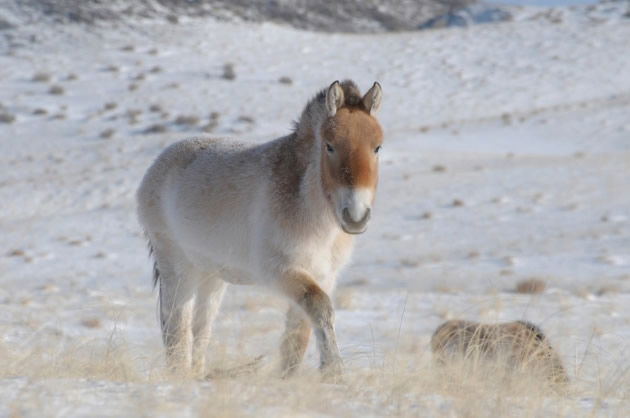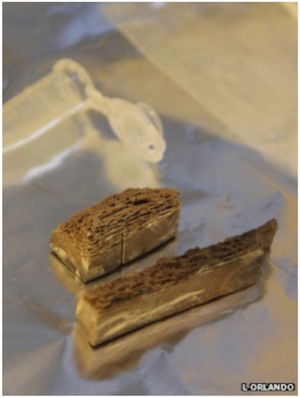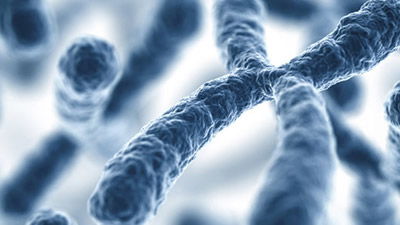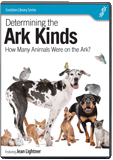
A Horse Is a Horse, of Course, of Course . . .
DNA from an ancient horse’s foot suggests horses have been horses for a long time.
News Sources
An old horse has reportedly set a new record, not for winning a race but for providing the oldest genome yet sequenced. A horse’s foot bone, found at Thistle Creek in the Canadian Yukon, has given up its genetic secrets to the research team of University of Copenhagen’s Eske Willerslev. Improved technology combined with the preservative role of the cold permafrost made it possible to sequence 70% of the horse’s genome. Believing the sequenced DNA to be 560,000 to 780,000 years old, coauthor Ludovic Orlando says, “We have beaten the time barrier. All of a sudden, you have access to many more extinct species than you could have ever dreamed of sequencing before.”
Comparison of the Thistle Creek horse’s genome with the genomes of modern domestic horses, a donkey, the wild Przewalski’s horse, and a Late Pleistocene horse suggests that all contemporary horses, zebras, and donkeys are descended from the same kind of ancestral horse. The genetic variation credited with enhancing racing performance, incidentally, is found only in our modern domestic horses.
The controversial Przewalski’s horse is truly distinct from the modern domestic line, the findings suggest, its genome untainted by human tinkering. Named after Russian explorer Nikolai Przhevalsky, Equus ferus przewalskii is native to the Mongolian steppes. Becoming extinct in the wild in the 1960s, the horse has been reintroduced through successful breeding programs. Though it has one more pair of chromosomes than the modern domestic horse, their offspring are fertile. Experts debate whether the Przewalski’s horse diverged from a common ancestor with modern domestic horses or later from the line of domestic horses themselves. Comparison of the Thistle Creek horse DNA with that of modern domestic breeds and Przewalski’s horses suggests the Thistle Creek horse antedated their divergence from each other.

Przewalski’s horses, the last remaining wild horses, are genetically distinct from modern domestic horses and zebras but share a common horse ancestor. Image by Claudia Feh, Association pour le cheval de Przewalski, via Nature.1
Asked to speculate on the Thistle Creek horse’s appearance, Willerslev said, since even the Przewalski’s horse differs somewhat from modern domestic breeds, “I would definitely say it would not look like a horse as we know it . . . but we would expect it to be a one-toed horse.”
These findings confirm what was already clear on the basis of both the Bible and biology: Zebras, horses, ponies, and donkeys are of the same created kind. Though we don’t have any three-toed horses around today to cross-breed with the one-toed variety, creation scientists consider a horse with three toes to still be a horse, a variant of the original created kind.2 In fact, the fossil record has revealed evidence of a single-toed and a three-toed horse found together.
“Pushing back the time barrier is important because it has implications for our evolutionary understanding of anything from hominins to other animals, because we can look further back in time than people have done previously,” Willerslev says. “There were many things we said wouldn't be possible in ancient DNA not that long ago, until next generation sequencing came along and all of a sudden everything has changed, and I mean everything.”

DNA recovered from this ancient horse’s foot bone demonstrates that donkeys, domestic horses, zebras, and wild Przewalski’s horses share a common horse ancestor. Image by L. Orlando, via BBC.3
Before the Thistle Creek horse foot’s genome was sequenced, the oldest sample to have its DNA successfully sequenced was a polar bear jaw deemed to be 130,000 years old. The jaw’s age was “stratigraphically validated.” In other words, its age was based on the usual radiometric dating assumptions applied to geologic strata in the vicinity of the fossilized jaw as well as the unverifiable assumptions used to calibrate infrared stimulated luminescence dating of the sediment around the fossil.4
The presence of preserved soft tissue in some fossils has led to recovery of collagen, keratin, and even blood cells and blood vessels. Mary Schweitzer in 2012 confirmed the presence of cellular proteins and even DNA5 in dinosaur soft tissue. But identifiable DNA is not the same as sequence-able DNA. DNA degrades rapidly after an organism’s death. One study using radiocarbon dating to evaluate an extinct bird’s bones suggested DNA has a half-life of 521 years6 but noted that conditions greatly affect preservation. Thus, the fact that the small amount of soft tissue in this horse bone produced DNA that could be sequenced is indeed remarkable and attests to the quality of the technology as well as the fortuitously cold conditions. And because investigators assign the horse’s bone an age of 560,000 to 780,000 years, evolutionary scientists have now expanded their thoughts on how long DNA can last.
The Thistle Creek horse bone was not tested for the presence of carbon-14 because Willerslev thought the location of the bone in the permafrost showed it was of “infinite radiocarbon date”7 and therefore too old to have any carbon-14 remaining in it. The foot bone was assigned an age based on radiometric dating of the host tephra, volcanic ash in which the horse was buried.
Geologist Dr. Andrew Snelling of Answers in Genesis explains:
Three methods were used. First was fission track dating, which is based on extrapolating the current rate of uranium fission and assuming it’s always been the same, and the samples were calibrated against a standard of “known age,” determined by Ar-Ar and U-Pb dating. Then they used paleomagnetic dating. The magnetic direction and strength “fossilized” in the rock when it cooled is measured, then compared against the paleomagnetic time scale. But that has been calibrated using K-Ar and Ar-Ar dating, which assumes today’s decay rate has been constant in the past. Third they used vertebrate paleontology, meaning the fossils in the tephra were compared to other vertebrate fossil assemblages of various “known” evolutionary ages.
So the bottom line is that as usual, once again, the dating all boils down to, and hinges on, radiometric dating methods that are subject to unverifiable assumptions about the past—decay rates, initial conditions, and no inheritance or contamination.
As for radiocarbon dating, I see no evidence of it being used on any of the samples or fossils, including wood found in the same tephra bed. So the comments about an “infinite radiocarbon date” are simply a throwaway line, because they have already decided it’s not worth looking for radiocarbon in such samples, which at supposedly 560,000-780,000 years old are “too old” for the method to work on them and would only supposedly give an “infinite radiocarbon age.” However, the published data in the journal Radiocarbon over the last 20–30 years indicates that even fossils supposedly 500 million years old when tested for radiocarbon yielded measurable radiocarbon equivalent to ages of only thousands of years. If they really did test for radiocarbon in this horse fossil bone, they might actually find some!
Applying these assigned dates to what is believed about the age of the oldest horse in the fossil record (2.0 million years),8 the investigators extrapolate backward through time to assert that a common ancestral horse evolved 4 million years ago. That they make this calculation by choosing assumptions that fit their presuppositions is illustrated by their statement that “Calibrations resulting in divergence times younger than the Thistle Creek bone age were rejected.”9 And having selected the calibration that provides internally consistent results, they write, “Our result indicates that the evolutionary timescale for the origin of contemporary equid diversity is at least twice that commonly accepted.”10 The circular reasoning underlying these dates is evident.
Molecular geneticist Dr. Georgia Purdom of Answers in Genesis comments:
While we would disagree that the horse ancestor lived millions of years ago (based on radiometric dating which uses unverifiable assumptions about the past), we would agree that all horses came from a common ancestor which, according to the Bible, was on the ark only around 4,300 years ago. The similarity of this fossil horse DNA to modern horse DNA further confirms that God created animals according to their kind (Genesis 1). There is variation within the kind, but even after the proposed hundreds of thousands of years the fossil and modern horse DNA are still very similar. We don't observe the types of changes necessary for a horse to evolve into a different kind of animal.
A pair of the equine kind got off Noah’s ark about 4,300 years ago, and genetic information in that pair provided the raw material for all the equine varieties we see today. Speciation mediated through natural selection and other means enabled their descendants to adapt to many environments in the post-Flood world.
God created animals to reproduce “after their kinds.” The fact that all these animals are able to mate and produce hybrid offspring that are fun to see and name—zonkeys, zorses, zebrulas, hebras, donkras, and mules—confirms they are of the same kind. The Thistle Creek DNA data, rightly interpreted, is consistent with biblical truth.
Further Reading
- Zonkeys, Ligers, and Wolphins, Oh My!
- What’s Happened to the Horse?
- News to Note, February 18, 2012
- Radiometric Dating: Problems with the Assumptions
- Radiometric Dating: Back to Basics
For More Information: Get Answers
Remember, if you see a news story that might merit some attention, let us know about it! (Note: if the story originates from the Associated Press, FOX News, MSNBC, the New York Times, or another major national media outlet, we will most likely have already heard about it.) And thanks to all of our readers who have submitted great news tips to us. If you didn’t catch all the latest News to Know, why not take a look to see what you’ve missed?
(Please note that links will take you directly to the source. Answers in Genesis is not responsible for content on the websites to which we refer. For more information, please see our Privacy Policy.)
Footnotes
- Erika Check Hayden, “First Horses Arose 4 Million Years Ago,” Nature, June 26, 2013, http://www.nature.com/news/first-horses-arose-4-million-years-ago-1.13261.
- The Hyracotherium, purported to be an ancestral horse by evolutionists, is neither a horse or ancestral to horses, however. See “What’s Happened to the Horse?”
- Jonathan Bull, “Ancient Horse Bone Yields Oldest DNA Sequence,” BBC, June 26, 2013, http://www.bbc.com/news/science-environment-23060993.
- Infrared luminescence dating assesses how much energy is stored in a mineral, assuming its electrons were excited by sunlight exposure in the past and trapped in crystalline imperfections. The energy it emits now when stimulated by heating is compared to emissions from specimens obtained from the present environment. This ratio is used to estimate how long the mineral has been buried. Like other dating methods, luminescence dating is calibrated on the basis of unverifiable uniformitarian assumptions. Can we know a sample has truly been in the dark for many thousands of years? Can we be sure no other factor such as heat or water exposure has altered the energy stored in it? Can we be certain the mineral’s sensitivity to energy has remained unchanged? It is impossible to know these conditions have been met. Furthermore, the overall method is calibrated by comparison to other dating methods based on their own unverifiable assumptions. (See “Preservation of Cellular Proteins in Dinosaur Fossils.”)
- See “Preservation of Cellular Proteins in Dinosaur Fossils.”
- See “DNA Decay Rate Evaluated.”
- L. Orlando et al., “Recalibrating Equus evolution using the genome sequence of an early Middle Pleistocene horse,” Nature (2013), doi:10.1038/nature12323.
- Ibid.
- Ibid.
- Ibid.
Recommended Resources

Answers in Genesis is an apologetics ministry, dedicated to helping Christians defend their faith and proclaim the good news of Jesus Christ.
- Customer Service 800.778.3390
- © 2024 Answers in Genesis






